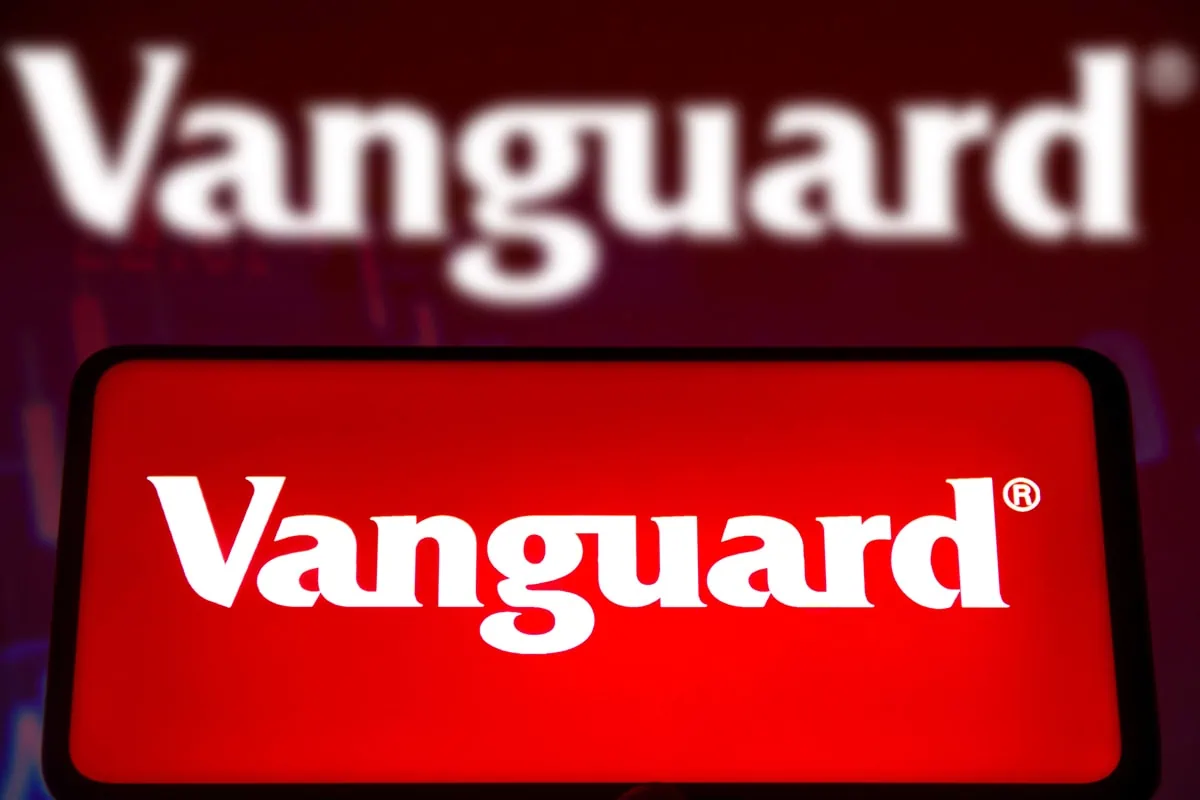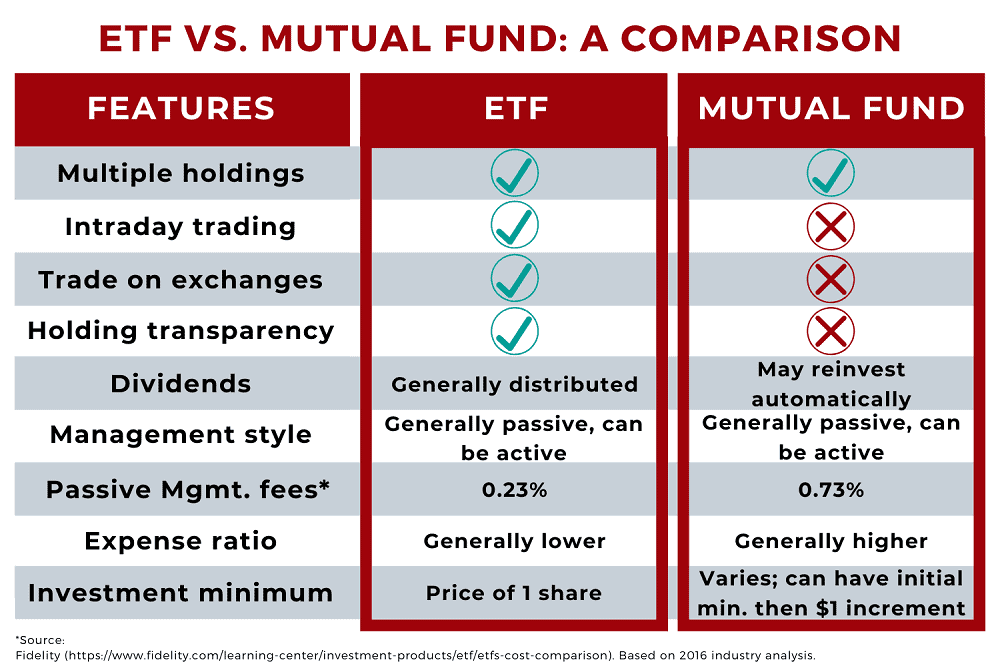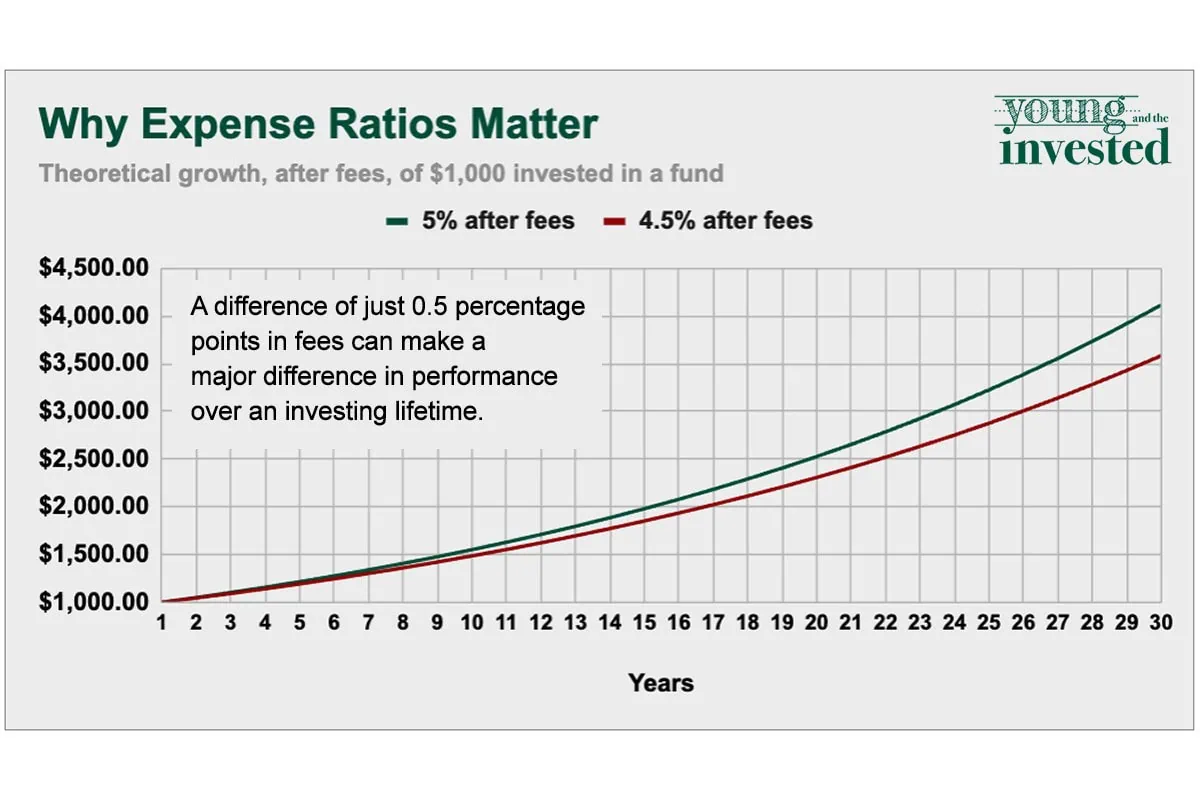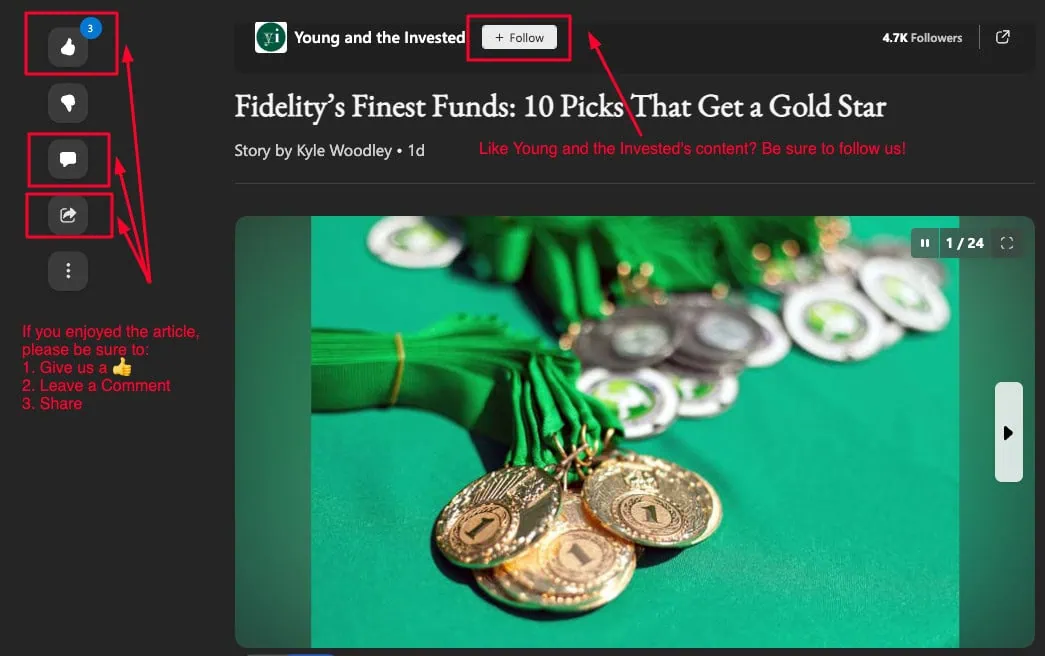If people speak with their wallets, then they must be yapping away about Vanguard ETFs.
Vanguard, like most of the market’s biggest fund providers, made its name for decades through its mutual fund suite. But no one should be surprised that one of the fund world’s low-cost leaders—one that pioneered the low-cost index, no less—is also a powerhouse when it comes to its exchange-traded funds (ETFs). Indeed, investors have piled more than $2 trillion dollars into Vanguard’s ETFs.
At least some of the attraction is the Vanguard name, no doubt. Low fees certainly contribute, too. But it’s more than just cost and reputation—Vanguard offers a variety of well-built ETFs that plug investors into not just core strategies, but also satellite themes that can be used to fine-tune a portfolio.
Want to see what I mean? Read on as I take a microscope to Vanguard’s best ETFs. This list includes a little something for everyone, whether it’s broad-market access, dividend growers, short-term government debt, or something in between.
Disclaimer: This article does not constitute individualized investment advice. These funds appear for your consideration and not as personalized investment recommendations. Act at your own discretion.
Editor’s Note: Tabular data shown in this article is up-to-date as of Sept. 24, 2025.
Table of Contents
What Is an ETF?

Let’s start with the most basic foundation: What is an exchange-traded fund (ETF)?
An ETF, in plain English, is an investment fund that owns different assets (stocks, bonds, etc.). However, unlike mutual funds, which only exchange hands once per trading day (after the close of regular trading), ETFs are listed on an exchange, much like individual stocks.
That means an ETF can fluctuate in price across the trading day according to the value of those underlying assets. So while they can be used for long-term buy-and-hold investing, they can also be used as trading instruments.
Why Vanguard?

Vanguard is the No. 2 asset manager in the world with nearly $11 trillion in assets under management, only trailing peer BlackRock ($12.5 trillion). And with that size comes a massive breadth of investment options, as well as efficiencies of scale that are difficult for smaller investment companies to match.
Indeed, Vanguard is using that scale to lower costs yet again. In early 2025, Vanguard announced its largest fee cut in history—a drop in price on 168 share classes across 87 funds that the firm predicts will save its investors $350 million in the first year alone.
It’s also worth noting that the best Vanguard ETFs are often low-cost, passive index funds. That means they are not aggressive vehicles that depend on overpaid managers to outperform the market, but rather “set it and forget it” funds tied to a fixed index of assets. This less flashy but more consistent approach has generally been shown to provide better long-term results.
The Best Vanguard ETFs

There is a massive universe of exchange-traded funds out there. So what makes the best Vanguard ETFs stand out over other ETFs?
A few factors include:
— Relatively low fees, not just nominally low fees. After all, just because a fund only costs you a couple dollars per year doesn’t mean there aren’t a bunch of cheaper alternative out there.
— Long-term potential. For the purpose of this article, we’re not talking about tactical or short-term bets, but rather foundational investments for the long haul.
— Different approaches for different investors. Also for the purpose of this article, we’re not looking for a single one-size-fits-all Vanguard ETF. Instead, the list is intended to be a menu of differentiated options that you can pick and choose from, based on your personal goals.
One final word of caution: Every investment carries risk, and even the best funds can lose you money if Wall Street suffers widespread declines.
With that disclaimer out of the way, let’s jump into the first Vanguard ETF on our list:
1. Vanguard S&P 500 ETF

— Style: U.S. large-cap stock
— Assets under management: $734.2 billion*
— Dividend yield: 1.2%
— Expense ratio: $0.03%, or 30¢ per year for every $1,000 invested
Many “best ETF” lists include an S&P 500 fund. It’s not laziness. It’s because S&P 500 funds work. Millions of American portfolios have large-cap stocks at their core, and the S&P 500 simply provides excellent exposure to large-cap stocks.
Many actively managed large-cap stock funds are benchmarked to the S&P 500; in other words, they’re tasked with beating the index’s performance. Unfortunately, according to S&P Dow Jones Indices, the majority of active large-cap U.S. equity funds have failed to top the S&P 500 in 22 of the past 25 years on a total-return basis (price plus dividends). That includes yet another majority underperformance in 2024, and 2025 is looking like more of the same.
But even if you compare the Vanguard S&P 500 ETF (VOO) and other low-cost S&P 500 index funds to all large-cap funds—active and index—they routinely land in the top quartile by performance across most meaningful time periods. So even among other indexes, the S&P 500 is great.
Related: The 7 Best Dividend ETFs [Get Income + Diversify]
By virtue of tracking the S&P 500, VOO owns shares in 500 of the largest American companies. It’s often used as a stock-market gauge of the U.S. economy given that its components encompass just about every type of business there is.
That doesn’t mean it’s evenly spread out. Technology is a huge part of our economy, and thus a huge part of VOO—35% of its assets right now, in fact. On the flip side, real estate, materials, and utilities merit less than 3% apiece. This happens because the S&P 500 is market capitalization-weighted, which means the greater the size of the company, the more “weight” it’s given in the index. So currently, trillion-dollar-plus companies Nvidia (NVDA), Microsoft (MSFT), and Apple (AAPL) are the largest constituents in the S&P 500, and thus VOO’s largest holdings.
The S&P 500’s sectors and holdings have changed a lot over time, and that hasn’t kept it from being an extremely productive index. So the imbalance is something you should be aware of, but not necessarily fear.
In short: VOO is one of the cheapest ways to buy a wide and fairly diversified set of American blue chips that has historically delivered excellent performance. And that makes it one of Vanguard’s best ETFs.
* Vanguard fund assets are spread across multiple share classes, including mutual funds and ETFs alike. Assets listed for each fund in this story are for the ETF share class only.
Do you want to get serious about saving and planning for retirement? Sign up for Retire With Riley, Young and the Invested’s free retirement planning newsletter.
2. Vanguard Total Stock Market ETF

— Style: U.S. total stock market
— Assets under management: $527.6 billion
— Dividend yield: 1.2%
— Expense ratio: $0.03%, or 30¢ per year for every $1,000 invested
If you want a little more exposure to stocks of all sizes, a “total stock market” fund might be more up your alley.
The Vanguard Total Stock Market ETF (VTI) is a one-stop shop for investors who want exposure to the totality of the U.S. stock market in a single investment. All told, this fund holds roughly 3,550 stocks, representing all sectors and sizes of companies.
Related: The 7 Best Vanguard Index Funds for Beginners
However, like the aforementioned VOO, Vanguard Total Stock Market ETF does not treat every component equally. It’s weighted most heavily toward the largest stocks; multitrillion-dollar tech giants Microsoft and Nvidia represent more than 6% of assets each, and Apple represents another 5%. That’s 17% of assets wrapped up in just three stocks. The same top-heaviness applies to its market-cap split; large caps are king at 70% of assets, while mid-caps account for 20% and the rest goes to small companies. And none of this construction is uncommon among “total stock market” funds.
VTI, while imperfect, is still an excellent solution for investors who just want to buy … well, virtually the whole U.S. stock market!
It’s also a popular solution; VTI is one of the top five exchange-traded funds in the U.S. by assets. So while it’s not particularly sophisticated, it’s still a favorite of investors who think long-term, buy-and-hold strategies are preferable to more complex options.
Related: 9 Best Fidelity ETFs for 2025 [Invest Tactically]
3. Vanguard Russell 1000 Growth ETF

— Style: U.S. large-cap growth stock
— Assets under management: $40.0 billion
— Dividend yield: 0.5%
— Expense ratio: 0.07%, or 70¢ per year for every $1,000 invested
Funds like VOO And VTI are commonly called “blend” funds, which refers to the fact that their holdings are a blend of two types of stocks:
Growth stocks: Companies with above-average past and/or expected rates of growth in operational metrics such as revenue and profits. They sometimes, but not always, trade at relatively expensive valuations.
Value stocks: Companies that trade for what is perceived by some to be less than their intrinsic value. They sometimes, but not always, feature slower past and/or expected rates of growth in operational metrics.
Investors concerned with locking in higher rates of portfolio return frequently look to the former, as high rates of operational growth can result in high levels of stock performance. Of course, the inherent risk is the high expectations: If a company expected to grow by leaps and bounds only grows modestly, their stock could suffer a drastic pullback.
But you can reduce the risk of any one growth stock imploding by holding a large group of them, which you get by purchasing funds such as the Vanguard Russell 1000 Growth ETF (VONG).
Related: The 7 Best Gold ETFs You Can Buy
VONG holds stocks within the Russell 1000 (the 1,000 largest U.S. companies by market capitalization) that boast relatively higher forecast two-year earnings growth, higher five-year historical sales growth … and higher price-to-book (P/B) ratios. It might seem odd to intentionally target relatively expensive stocks, but even though growth and value aren’t inherently at odds (you certainly can find growth stocks that trade at relative bargains), they’re often treated that way.
The resulting portfolio is made of 390 growth stocks that are predominantly clustered in growth-oriented sectors. Technology accounts for more than of assets right now, followed by consumer discretionary (13%) and communication services (12%). Top holdings are a who’s who of blue-chip growth, including Nvidia, Amazon (AMZN), and Facebook parent Meta Platforms (META).
Related: The Best Index Funds to Buy for 2025
4. Vanguard Dividend Appreciation ETF

— Style: U.S. dividend-growth stock
— Assets under management: $95.7 billion
— Dividend yield: 1.7%
— Expense ratio: 0.05%, or 50¢ per year for every $1,000 invested
One of the most popular ways for investors to reduce their risk profile in the stock market is to lean on dividend stocks. These are the stocks of companies that pay a portion of their profits back to shareholders in the form of cash distributions (“dividends”).
Stocks that pay dividends regularly tend to produce significant, reliable profits, which is how they’re able to afford those dividends. That implies a certain level of quality. And just as important: These dividends can provide another source of income aside from price returns.
Related: 12 Best Investment Opportunities for Accredited Investors
The Vanguard Dividend Appreciation ETF (VIG) is composed of dividend stocks that boast track records of improving those dividend payments over time. VIG’s portfolio, which is currently about 340 stocks, includes dividend growers such as semiconductor firm Broadcom (AVGO), mega-bank JPMorgan Chase (JPM), and credit card titan Visa (V), to name a few.
Dividend growth is an important indication of good financial health, as well as an important factor in compound returns over time. As your cash payments grow larger and larger over time, that’s more money you can reinvest back into the stock, which in turn will keep paying you increasing dividends. Even once you call it a career, and you’re using those dividends as retirement income, the steady growth in those paydays can help you fend off the dollar-eroding effects of inflation.
If you want to focus on rock-solid dividend growers in 2025, this Vanguard ETF is worth a look.
Related: The 7 Best Closed-End Funds (CEFs)
5. Vanguard Real Estate ETF

— Style: Sector (Real estate)
— Assets under management: $34.5 billion
— Dividend yield: 3.8%
— Expense ratio: 0.13%, or $1.30 per year for every $1,000 invested
You might have noticed that while VIG’s holdings might offer lower risk and growing payouts, the current dividend yield isn’t particularly impressive. Some investors prefer more yield up front; for those, one option is the Vanguard Real Estate ETF (VNQ)—the best Vanguard ETF for investing in real estate and one of the sector’s most popular funds period.
VNQ holds real estate investment trusts, or REITs—a special class of company that enjoys operational tax breaks to accommodate the capital-intensive nature of real estate and property management. However, in exchange for those tax breaks, REITs must deliver 90% of taxable income back to their shareholders. This typically results in greater-than-average dividends. And the best REITs, which are able to produce the most regular and growing cash flows from their properties, are as consistent an investment as you’ll find on Wall Street.
Related: The 10 Best Vanguard Index Funds You Can Buy
The Vanguard Real Estate ETF currently holds about 155 REITs, chief among them health care property owner Welltower (WELL), industrial warehouse giant Prologis (PLD), and telecom infrastructure play American Tower (AMT). Best of all? This portfolio collectively delivers a yield of nearly 4% that is more than thrice what the broader market pays.
Sadly, most of us can’t afford to buy a second home or an office building to rent out to tenants directly. Fortunately, we can still tap into the real estate market’s big income potential through ETFs like VNQ.
6. Vanguard Information Technology ETF

— Style: Sector (Technology)
— Assets under management: $100.5 billion
— Dividend yield: 0.5%
— Expense ratio: 0.09%, or 90¢ per year for every $1,000 invested
The flip side of low-risk dividend stocks and REITs are high-growth companies that pump most if not all of their profits back into the business in hopes of rapid expansion.
That’s what the Vanguard Information Technology ETF (VGT) has to offer.
Related: The 10 Best Fidelity Funds You Can Own
VGT holds technology stocks, to no one’s surprise. Its 315 holdings include many of the big names you already know (like Apple and Microsoft), as well as smaller software developers, chipmakers, and other growth-oriented technology firms that are trying to make a name for themselves.
The tech sector thrived in 2023 and 2024, and VGT was among the best Vanguard ETFs as a result. But keep in mind the sector doesn’t always come out on top. In 2022, even the biggest and most established names in Silicon Valley faced serious headwinds. And tech spent a good part of 2025’s first half getting knocked around.
Still, if you’re taking a long view, it’s difficult to imagine a future where high-tech stocks are not among the biggest winners—and this Vanguard ETF plays into this trend.
Like Young and the Invested’s Content? Be sure to follow us.
7. Vanguard U.S. Multifactor ETF

— Style: U.S. multifactor
— Assets under management: $375.4 million
— Dividend yield: 1.6%
— Expense ratio: 0.18%, or $1.80 per year for every $1,000 invested
Most investment funds are designed to give you exposure to a certain part of the market, however wide or narrow that part of the market might be. The whole stock market. A sector. A country. Certain types of bonds. You get the picture. To find more ideal holdings within that slice of the market, index funds might have certain inclusion criteria, and actively managed funds will rely on managers’ discretion. But the purpose of these funds largely remains “access to such and such part of the market.”
However, if you just wanted, say, a great collection of stocks no matter what they might look like, you might want to seek out “multifactor” funds.
Related: Best Schwab Index Funds for Thrifty Investors
Index provider MSCI defines factors well: “A factor is any characteristic that helps explain the long-term risk and return performance of an asset.” If you’ve invested for any amount of time, you’re already well-aware of the two most prominent factors: value and growth. But there are others, including volatility, dividend yield, price momentum, and more. A multifactor fund, then, invests in securities that meet criteria across several factors in hopes of building a more optimal portfolio.
The Vanguard U.S. Multifactor ETF (VFMF) is an actively managed multifactor fund, though it sticks tightly to a rules-based quantitative model to ensure its holdings meet several factor gates. After an initial universe of U.S. stocks is screened to remove the 20% most volatile stocks across each market cap grouping, the remaining stocks are chosen based on three more factors:
— Value: Book value-to-price and forward earnings-to-price (also operating cash flows-to-price for non-financial-sector companies)
— Quality: Financial sector: Return on equity, share issuance; Non-financials: Return on equity, gross profitability, change in net operating assets, leverage
— Momentum: Total returns (price plus dividends) from 12 months ago to one month ago, total returns from 7 months ago to one month ago, and the intercept from a one-year regression of stock returns on their regional benchmark.
Related: 11 Best Alternative Investments [Options to Consider]
The resulting portfolio is … well, Morningstar categorizes it as “mid-cap value,” but that’s misleading. In truth, it’s just extremely well-balanced across market caps right now, at roughly 25% of assets in each of the large-, mid-, small-, and micro-cap space. (Micro-caps are between $50 million and $300 million by market capitalization and often are included as part of a fund’s small-cap count.) From a sector perspective, financial stocks are the top weight at about 30%, followed by health care (15%), technology (12%), and consumer discretionary (12%).
But Vanguard U.S. Multifactor’s nature suggests that these size and sector weightings could fluctuate, and in fact, they do. What matters is whether you’re getting something better than ordinary, and on that front, VFMF does the job.
VFMF is fairly young, having launched in 2018, so five-year returns are our best gauge. Vanguard’s ETF has topped the S&P 500 over that time on a total-return basis. However, the S&P 500 is predominantly large-cap, which has also beaten the pants off of mid- and small caps over the past five years. A better measure would be pitting VFMF against a portfolio similarly weighted across Vanguard’s large-, mid-, and small-cap funds. On that front, Vanguard U.S. Multifactor has done even better, outperforming by more than 3 percentage points annually.
Related: The 15 Best ETFs to Buy for a Prosperous 2025
8. Vanguard Total International Stock ETF

— Style: International stock
— Assets under management: $102.7 billion
— Dividend yield: 2.7%
— Expense ratio: 0.05%, or 50¢ per year for every $1,000 invested
Up until this point, I’ve only covered different ways to slice up the U.S. stock market. But if you look just beyond our borders, you’ll find an even bigger universe of companies just waiting for our capital.
The Vanguard Total International Stock ETF (VXUS) is one of the most popular ways to invest in international firms. It’s an “ex-U.S.” product, meaning it is designed to exclude companies in the United States to ensure the holdings don’t overlap with any domestic stock ETFs. However, VXUS’s massive portfolio of more than 8,600 stocks still includes plenty of familiar names, including chip giant Taiwan Semiconductor (TSM), German software company SAP (SAP), and Swiss foods multinational Nestlé (NSRGY).
Related: 10 Best Vanguard Funds for the Everyday Investor
Indeed, VXUS, like many of the other Vanguard funds on this list, is market cap-weighted, so it leans heavily on large caps, which account for roughly three-quarters of assets. The upside? International dividend payers tend to offer up bigger yields than their American counterparts. Vanguard Total International Stock ETF’s current yield is well more than twice the S&P 500’s.
In an interconnected global economy, it’s a bit naive to think that multinational companies only rise and fall based on their local economies. That’s true for big U.S. names as well as the international giants that lead this Vanguard ETF.
So if you want international diversification to truly play broad economic trends in 2025 and beyond, consider layering VXUS into your portfolio.
Related: 9 Best Fidelity Index Funds to Buy
9. Vanguard FTSE Emerging Markets ETF

— Style: Emerging-markets stock
— Assets under management: $96.1 billion
— Dividend yield: 2.7%
— Expense ratio: 0.07%, or 70¢ per year for every $1,000 invested
The aforementioned VXUS is loaded up with companies from developed markets—nations with more established markets but also slower-growing economies. That’s great if you want stability and yield; not so much if you want more aggressive price returns.
If you’d prefer to invest in higher-growth “emerging markets” like those found in Asia and South America, you’re better off with a fund like the Vanguard FTSE Emerging Markets ETF (VWO).
Related: 9 Best Real Estate Crowdfunding Sites + Platforms
This Vanguard ETF is a simple index product that plugs investors into 6,000 companies from about two dozen emerging markets. But they’re not spread out evenly—China is king at more than a third of assets, followed by 20% allocations to Taiwan and India. Other countries, such as Egypt and Iceland, have merely token representation at fractional weights.
Funds like VWO help you own a lot of stocks you’d have trouble owning otherwise. While a few of VWO’s holdings—blue chips like Asia e-commerce giant Alibaba Group (BABA), for instance—trade on America’s major exchanges and are accessible to most investors, many smaller components only trade “over the counter” in the U.S., or worse, only on foreign exchanges.
Self-directed investors would suffer quite a few headaches trying to own all these stocks individually. But this Vanguard ETF does the trick easily and inexpensively.
Related: 5 Best Fidelity Retirement Funds [Low-Cost + Long-Term]
10. Vanguard Total Bond Market ETF

— Style: U.S. intermediate-core bond
— Assets under management: $135.9 billion
— SEC yield: 4.2%*
— Expense ratio: 0.03%, or 30¢ per year for every $1,000 invested
Investors looking for ways to add income and relative safety to their portfolios often opt for bonds.
Of course, bonds come in all shapes and sizes—from U.S. government bonds, to high-quality corporate bonds from top blue-chip companies, to riskier “junk” bonds from borrowers who are facing real challenges to operations. So if you’re already confused by the thousands of options in the stock market, looking into bonds on top of that would probably be downright overwhelming.
Related: 10 Best Dividend Stocks to Buy
That’s why many investors just opt to buy a bond fund and call it a day.
Vanguard Total Bond Market ETF (BND) is the best Vanguard ETF for diversified exposure to all these categories (except for the riskiest bonds out there). BND has a gigantic portfolio of more than 11,400 debt issues, including U.S. Treasury and agency bonds, corporate bonds, even mortgage-backed securities. The portfolio is entirely investment-grade, too—BND doesn’t hold “junk” debt”—so you’re getting not only a ton of diversification, but also peace of mind.
Duration (a measure of interest-rate risk) is 5.8 years, which implies that if market interest rates climbed by 1 percentage point, BND would experience a short-term decline of 5.8%; and if rates dropped by a point, BND would climb by 5.8%.
Related: 7 Best High-Quality, High-Yield Dividend Stocks to Buy
Bonds don’t deliver the quick gains that stocks can. But they offer steady and reliable income—which for many investors is worth the lower potential reward to provide a lower overall risk profile to their portfolio.
* SEC yield reflects the interest earned across the most recent 30-day period. This is a standard measure for funds holding bonds and preferred stocks.
Do you want to get serious about saving and planning for retirement? Sign up for Retire With Riley, Young and the Invested’s free retirement planning newsletter.
11. Vanguard Short-Term Treasury ETF

— Style: Short-term U.S. Treasury bond
— Assets under management: $22.8 billion
— SEC yield: 3.7%
— Expense ratio: 0.03%, or 30¢ per year for every $1,000 invested
Just like stocks, bonds have varying levels of risk and potential reward. The Vanguard Short-Term Treasury ETF (VGSH) focuses on a subset of bonds that have very low risk for two reasons: They have short maturities, and they’re issued by the U.S. Treasury.
Maturity helps determine risk. Generally speaking, the longer the bond, the greater the risk that the bond might not be repaid. Interest rates come into play, too. When rates go higher, new bonds pay more, which tempt people to sell their old bonds for the new, higher-paying bonds. But the temptation is much greater when you’re dealing with longer-term bonds with lots of payments remaining—and not so great for short-term bonds with one or just a couple payments left.
Related: Do I Need a Financial Advisor? 7 Questions to Ask Yourself
Meanwhile, U.S. Treasury bonds, which are backed by the full faith and credit of the U.S. government, are some of the highest-rated bonds on the planet. Is there 100% certainty they’ll be repaid? No. But there is a higher likelihood of repayment than the vast majority of issuers out there.
Vanguard Short-Term Treasury ETF invests in fewer than 100 Treasury bond issues with maturities of between one and three years. And the lower risk is reflected in the averaged duration, which currently sits at just 1.9 years, compared to 5.8 years for Vanguard Total Bond Market. This means that, in theory, a 1-percentage-point hike in interest rates would knock BND 5.8% lower in the short term, but VGSH would only decline by 1.9%. Conversely, VGSH wouldn’t rise as much if interest rates declined.
But that’s OK, as long as you know what you’re buying. If all you want is portfolio protection that can still generate some yield (in the upper 3% range currently), VGSH is one of the best Vanguard ETFs you can buy.
Related: The Best Index Funds for Beginners
Learn More About These and Other Funds With Morningstar Investor

If you’re buying a fund you plan on holding for years (if not forever), you want to know you’re making the right selection. And Morningstar Investor can help you do that.
Morningstar Investor provides a wealth of information and comparable data points about mutual funds and ETFs—fees, risk, portfolio composition, performance, distributions, and more. Morningstar experts also provide detailed explanations and analysis of many of the funds the site covers.
With Morningstar Investor, you’ll enjoy a wealth of features, including Morningstar Portfolio X-Ray®, stock and fund watchlists, news and commentary, screeners, and more. And you can try it before you buy it. Right now, Morningstar Investor is offering a free seven-day trial. You can check out the current deal, as well as discounted rates for students and teachers, by visiting Morningstar’s site.
Like Young and the Invested’s Content? Be sure to follow us.
Are ETFs the Same Thing as Index Funds?

Not always. Most ETFs are index funds, meaning they are tied to a fixed “index” or list of securities. However, mutual funds can also be tied to indexes and thus be categorized as index funds, too. Similarly, both ETFs and mutual funds can instead follow a more dynamic or “active” list of investments.
It can be confusing sometimes, but the bottom line is you should always read the investment materials an asset manager provides and look for a description.
In the case of Vanguard, you’ll find a heading labeled “investment style” at the top of most ETF pages that will clearly identify whether funds are index funds, or active funds.
Like Young and the Invested’s Content? Be sure to follow us.
What Is a Mutual Fund?

A mutual fund is an investment company that pools money from many investors to buy stocks, bonds or other securities. The investors get the benefits of professional management and certain economies of scale. A pool of potentially millions or even billions of dollars is large enough to diversify and might have access to investments that would be impractical for an individual investor to own.
Here’s an example: An investor wanting to mimic the S&P 500 Index (an index made up of 500 large, U.S.-listed companies) would generally have a hard time buying and managing a portfolio of 500 individual stocks, especially in the exact proportions of the S&P 500 Index. Another example: An investor wanting a diversified bond portfolio might have a hard time building one when individual bond issues can have minimum purchase sizes of thousands (or tens of thousands!) of dollars.
Equity funds or bond funds will generally be a far more practical solution.
ETFs vs. Mutual Funds

You might be familiar with this concept of bundled assets because that’s how traditional mutual funds work. But with mutual funds, all buying and selling happens just once each trading day, after the markets close at 4 p.m. ETFs, on the other hand, are available to buy and sell across the trading day.
ETFs are also structured differently than mutual funds and their other cousins, closed-end funds (CEFs), which tends to make them a little more tax-efficient. Also, unlike mutual funds, ETFs don’t have minimum investment thresholds—the minimum cost is just one share (or less if your broker offers fractional shares).
Lastly, ETFs tend to have cheaper fees than mutual funds, on average, but that’s because most ETFs are passively managed index funds, whereas most mutual funds are run by one or more human managers. But there are more expensive actively managed ETFs and cheap index mutual funds.
Does Vanguard Offer a Minimum-Volatility ETF?

Yes: The Vanguard U.S. Minimum Volatility ETF (VFMV). But investors should note two things about this ETF:
1. This is not an index fund. VFMV is actively managed by the Vanguard Quantitative Equity Group. Despite that, it does charge a fairly low fee of just 0.13%, or $1.30 annually for every $1,000 invested.
2. This is a minimum-volatility ETF, which is different than a low-volatility ETF. Min-vol funds typically try to reduce volatility while still maintaining some similarity to an underlying index–in this case, VFMV management will try to pick stocks they expect will have lower volatility than the market, but still hold stocks of varying sizes (large, mid, and small), from different industries and groups. Low-vol ETFs, however, typically invest in stocks based on backward-looking measures of volatility, and often aim for the lowest volatility possible without trying to mimic an index. For instance, a min-vol market ETF might be required to hold at least a 5% weight in all 11 sectors; a low-vol market ETF might hold the lowest-volatility stocks within the market, and as a result, some sectors simply might not be included.
Related: The 7 Best Fidelity Index Funds for Beginners
Why Does a Fund’s Expense Ratio Matter So Much?

Every dollar you pay in expenses is a dollar that comes directly out of your returns. So, it is absolutely in your best interests to keep your expense ratios to an absolute minimum.
The expense ratio is the percentage of your investment lost each year to management fees, trading expenses and other fund expenses. Because index funds are passively managed and don’t have large staffs of portfolio managers and analysts to pay, they tend to have some of the lowest expense ratios of all mutual funds.
This matters because every dollar not lost to expenses is a dollar that is available to grow and compound. And over an investing lifetime, even a half a percent can have a huge impact. If you invest just $1,000 in a fund generating 5% per year after fees, over a 30-year horizon, it will grow to $4,116. However, if you invested $1,000 in the same fund, but it had an additional 50 basis points in fees (so it only generated 4.5% per year in returns), it would grow to only $3,584 over the same period.
Like Young and the Invested’s Content? Be sure to follow us.
Want to talk more about your financial goals or concerns? Our services include comprehensive financial planning, investment management, estate planning, taxes, and more! Schedule a call with Riley to discuss what you need, and what we can do for you.
The 10 Best-Rated Dividend Aristocrats Right Now

Dividend growth puts more cash in our pockets and signals that the company we’re invested in is confident in its ability to keep churning out profits. And there’s no more heralded group of dividend growers than the Dividend Aristocrats, which are companies that have paid higher cash distributions each year for at least a quarter-century.
But even Aristocrats aren’t created equally. Check out which dividend growers Wall Street loves the best right now in our list of the top-rated Dividend Aristocrats.
13 Best Long-Term Stocks to Buy and Hold Forever

As even novice investors probably know, funds—whether they’re mutual funds or exchange-traded funds (ETFs)—are the simplest and easiest ways to invest in the stock market. But the best long-term stocks also offer many investors a way to stay “invested” intellectually—by following companies they believe in. They also provide investors with the potential for outperformance.
So if you’re looking for a starting point for your own portfolio, look no further. Check out our list of the best long-term stocks for buy-and-hold investors.
Please Don’t Forget to Like, Follow and Comment

Did you find this article helpful? We’d love to hear your thoughts! Leave a comment with the box on the left-hand side of the screen and share your thoughts.
Also, do you want to stay up-to-date on our latest content?
1. Follow us by clicking the [+ Follow] button above,
2. Subscribe to Retire With Riley, our free weekly retirement planning newsletter, and
3. Give the article a Thumbs Up on the top-left side of the screen.
4. And lastly, if you think this information would benefit your friends and family, don’t hesitate to share it with them!
Kyle Woodley was long VOO and VNQ as of this writing.






